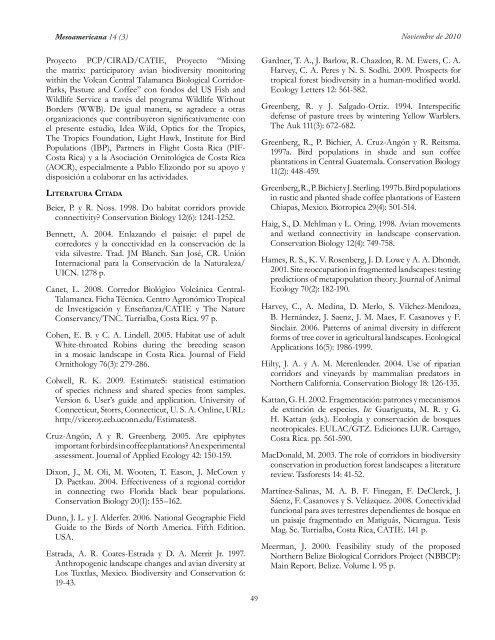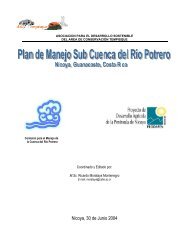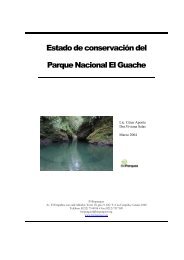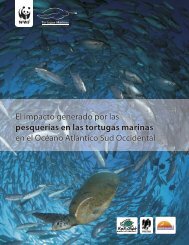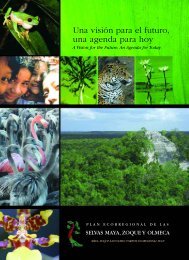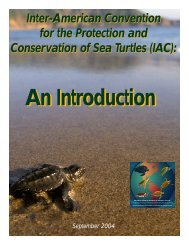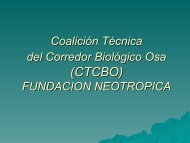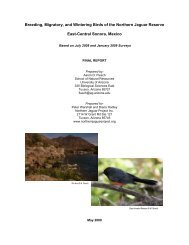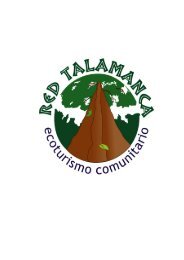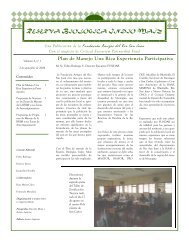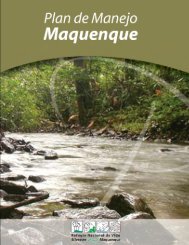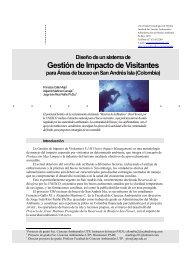Mesoamericana <strong>14</strong> (3) <strong>Noviembre</strong> <strong>de</strong> <strong>2010</strong><strong>de</strong> bosque son indispensables (MacDonald, 2003).Con relación a los meses <strong>de</strong> monitoreo (2008) indicanla importancia <strong>de</strong> los sistemas agroforestales, para laconservación <strong>de</strong> la avifauna <strong>de</strong>ntro <strong>de</strong> agropaisajes.Importantes especialmente para la conservación <strong>de</strong>especies migratorias (Figura 3, Tabla 3), quienes estuvieronmayormente asociadas a sistemas agroforestales <strong>de</strong> café ycacao. En este sentido, los sistemas agroforestales <strong>de</strong> cafépromueven corredores biológicos importantes a nivelinternacional para este grupo taxonómico.La importancia <strong>de</strong> estos agroecosistemas tambiényace en que <strong>de</strong>ntro <strong>de</strong> paisajes productivos, se conviertenen una buena opción para mantener y ayudar a mejorarla conectividad <strong>de</strong>l paisaje con elementos que pue<strong>de</strong>ncontribuir al movimiento <strong>de</strong> las especies y a la viabilidad <strong>de</strong>poblaciones aisladas, a través <strong>de</strong> la colonización <strong>de</strong> otroselementos <strong>de</strong>ntro <strong>de</strong>l paisaje (Revilla et al., 2004). Estoúltimo es crítico para la sobrevivencia <strong>de</strong> las poblacionesanimales (Taylor et al., 1993; Hames et al., 2001).Un ejemplo <strong>de</strong> la importancia <strong>de</strong> estos sistemas comoconectores <strong>de</strong>ntro <strong>de</strong> un paisaje productivo, fue la captura<strong>de</strong> un individuo macho joven <strong>de</strong> Corapipo altera (Pipridae)en el hábitat <strong>de</strong> cercas vivas y dos en el hábitat bosque(Tabla 4). Consi<strong>de</strong>rando estudios previos con especies <strong>de</strong>esta familia, que han <strong>de</strong>mostrado que individuos machossuelen ser más se<strong>de</strong>ntarios que las hembras y los jóvenes(Snow, 1962), se infiere que este individuo se dispersabaen busca <strong>de</strong> nuevos territorios, proceso ecológico bastantedifícil <strong>de</strong> <strong>de</strong>tectar y documentar (Haig et al., 1998) y <strong>de</strong> granimportancia para la dinámica <strong>de</strong> poblaciones (Schumaker,1996; Revilla et al., 2004).Se resalta la importancia <strong>de</strong> los agroecosistemas comoconectores y hábitats temporales para muchas especies<strong>de</strong> aves (Taylor et al., 1993; Martínez-Salinas et al., 2008),ya sea para incursiones ocasionales <strong>de</strong>ntro <strong>de</strong> la matriz<strong>de</strong>l paisaje o bien para lograr la dispersión exitosa haciaotros elementos <strong>de</strong>ntro <strong>de</strong>l mismo (Schumaker, 1996;Beier y Noss, 1998; Sieving et al., 2000; Martínez-Salinaset al., 2008) que puedan contribuir a la permanencia <strong>de</strong>estas especies en aquellos que son productivos en el largoplazo.También es importante consi<strong>de</strong>rar que mayor esfuerzo<strong>de</strong> monitoreo pue<strong>de</strong> ayudar a aumentar observaciones <strong>de</strong>este fenómeno, y se reconoce que datos sobre la dispersión<strong>de</strong> juveniles son <strong>de</strong> gran importancia para enten<strong>de</strong>r elpapel que juegan los agropaisajes en la distribución <strong>de</strong>especies <strong>de</strong>pendientes <strong>de</strong> bosque y para la viabilidad <strong>de</strong> suspoblaciones.Este primer año <strong>de</strong> datos, también muestra el uso <strong>de</strong>sistemas agroforestales por parte <strong>de</strong> especies <strong>de</strong> avestradicionalmente asociadas a bosque, caso contrario aáreas como pasturas y cercas vivas que están por lo generaldominadas por especies generalistas (Ramírez, 2006;Vilchez-Mendoza et al., 2008). El sistema multiestrato<strong>de</strong> cacao, que es el que muestra estructuralmente mayorsimilitud con el bosque (Tabla 1), fue el hábitat quetambién compartió el mayor número <strong>de</strong> especies (Figura6). Este resultado también llama la atención a métodos <strong>de</strong>evaluación <strong>de</strong> la biodiversidad en paisajes agrícola, usandoíndices <strong>de</strong> riqueza y abundancia, el bosque queda con el uso<strong>de</strong> suelo con menor valor para la conservación, y el hábitatcercas vivas como el <strong>de</strong> mayor valor. Tomando en cuentaque el objetivo es conservar especies <strong>de</strong> aves <strong>de</strong>pendientes<strong>de</strong> bosque, se constata que índices <strong>de</strong> similitud, en conjuntocon índices <strong>de</strong> riqueza y abundancia proporcionan mayorinformación.En el caso particular <strong>de</strong> las cercas vivas, su importanciapara la provisión <strong>de</strong> hábitat para aves y otros taxa (Estradaet al., 1997; Vilchez-Mendoza et al., 2008), así como parala conectividad estructural <strong>de</strong>ntro <strong>de</strong> paisajes agrícolasha sido <strong>de</strong>mostrada. Sin embargo, aún queda muchoque documentar sobre el valor <strong>de</strong> estos hábitats para laconservación <strong>de</strong> la avifauna en el largo plazo. Harvey etal. (2006) resaltan que su importancia <strong>de</strong>pen<strong>de</strong> <strong>de</strong> diversasvariables como la composición <strong>de</strong> especies, la diversida<strong>de</strong>structural y el arreglo espacial <strong>de</strong>ntro <strong>de</strong> un paisajedado, así como <strong>de</strong> los usos adyacentes a cada uno <strong>de</strong> loshábitats consi<strong>de</strong>rados (Tischendorf y Fahrig, 2000; Norrisy Stutchbury, 2001; Van<strong>de</strong>rmeer y Carvajal, 2001), que sonfundamentales para <strong>de</strong>terminar la presencia-ausencia <strong>de</strong>algunas especies <strong>de</strong> interés para la conservación.Por último, el monitoreo a largo plazo es indispensablepara tener evi<strong>de</strong>ncia sobre el valor <strong>de</strong> conservación <strong>de</strong>estos hábitats, particularmente mayor información sobrela dispersión en función a la biología <strong>de</strong> especies <strong>de</strong> interés.Aún más importante sí se realiza <strong>de</strong>ntro <strong>de</strong> áreas comocorredores biológicos, que si bien su importancia yaha sido documentada (Beier y Noss; 1998; Dixon et al.,2004), los datos obtenidos en el largo plazo contribuiránsignificativamente al <strong>de</strong>sarrollo <strong>de</strong> estrategias que apoyenefectivamente la conservación. A<strong>de</strong>más <strong>de</strong> validar laimportancia <strong>de</strong> estas estrategias para la conservación <strong>de</strong> labiodiversidad en agroecosistemas.Ag r a d e c i m i e n t o sEl Programa Monitoreo <strong>de</strong> Aves (PMA) agra<strong>de</strong>ceespecialmente a los voluntarios que en diferentes períodoscontribuyeran con su valiosa participación en la obtención<strong>de</strong> datos, sin ellos este programa no existiría. A SergioVilchez-Mendoza por su colaboración en el análisis <strong>de</strong>los datos y su ayuda en campo. Se agra<strong>de</strong>ce también a losproyectos que apoyaron el <strong>de</strong>sarrollo <strong>de</strong> las activida<strong>de</strong>s <strong>de</strong>investigación y educación, Proyecto CAFNET/CATIE,48
Mesoamericana <strong>14</strong> (3) <strong>Noviembre</strong> <strong>de</strong> <strong>2010</strong>Proyecto PCP/CIRAD/CATIE, Proyecto “Mixingthe matrix: participatory avian biodiversity monitoringwithin the Volcan Central Talamanca Biological Corridor-Parks, Pasture and Coffee” con fondos <strong>de</strong>l US Fish andWildlife Service a través <strong>de</strong>l programa Wildlife WithoutBor<strong>de</strong>rs (WWB). De igual manera, se agra<strong>de</strong>ce a otrasorganizaciones que contribuyeron significativamente conel presente estudio, I<strong>de</strong>a Wild, Optics for the Tropics,The Tropics Foundation, Light Hawk, Institute for BirdPopulations (IBP), Partners in Flight Costa Rica (PIF-Costa Rica) y a la Asociación Ornitológica <strong>de</strong> Costa Rica(AOCR), especialmente a Pablo Elizondo por su apoyo ydisposición a colaborar en las activida<strong>de</strong>s.Li t e r a t u r a Ci ta d aBeier, P. y R. Noss. 1998. Do habitat corridors provi<strong>de</strong>connectivity? Conservation Biology 12(6): 1241-1252.Bennett, A. 2004. Enlazando el paisaje: el papel <strong>de</strong>corredores y la conectividad en la conservación <strong>de</strong> lavida silvestre. Trad. JM Blanch. San José, CR. UniónInternacional para la Conservación <strong>de</strong> la Naturaleza/UICN. 1278 p.Canet, L. 2008. Corredor Biológico Volcánica Central-Talamanca. Ficha Técnica. Centro Agronómico Tropical<strong>de</strong> Investigación y Enseñanza/CATIE y The NatureConservancy/TNC. Turrialba, Costa Rica. 97 p.Cohen, E. B. y C. A. Lin<strong>de</strong>ll. 2005. Habitat use of adultWhite-throated Robins during the breeding seasonin a mosaic landscape in Costa Rica. Journal of FieldOrnithology 76(3): 279-286.Colwell, R. K. 2009. EstimateS: statistical estimationof species richness and shared species from samples.Version 6. User’s gui<strong>de</strong> and application. University ofConnecticut, Storrs, Connecticut, U. S. A. Online, URL:http://viceroy.eeb.uconn.edu/Estimates8.Cruz-Angón, A y R. Greenberg. 2005. Are epiphytesimportant for birds in coffee plantations? An experimentalassessment. Journal of Applied <strong>Eco</strong>logy 42: 150-159.Dixon, J., M. Oli, M. Wooten, T. Eason, J. McCown yD. Paetkau. 2004. Effectiveness of a regional corridorin connecting two Florida black bear populations.Conservation Biology 20(1): 155–162.Dunn, J. L. y J. Al<strong>de</strong>rfer. 2006. National Geographic FieldGui<strong>de</strong> to the Birds of North America. Fifth Edition.USA.Estrada, A. R. Coates-Estrada y D. A. Merrit Jr. 1997.Anthropogenic landscape changes and avian diversity atLos Tuxtlas, Mexico. Biodiversity and Conservation 6:19-43.49Gardner, T. A., J. Barlow, R. Chazdon, R. M. Ewers, C. A.Harvey, C. A. Peres y N. S. Sodhi. 2009. Prospects fortropical forest biodiversity in a human-modified world.<strong>Eco</strong>logy Letters 12: 561-582.Greenberg, R. y J. Salgado-Ortiz. 1994. Interspecific<strong>de</strong>fense of pasture trees by wintering Yellow Warblers.The Auk 111(3): 672-682.Greenberg, R., P. Bichier, A. Cruz-Angón y R. Reitsma.1997a. Bird populations in sha<strong>de</strong> and sun coffeeplantations in Central Guatemala. Conservation Biology11(2): 448-459.Greenberg, R., P. Bichier y J. Sterling. 1997b. Bird populationsin rustic and planted sha<strong>de</strong> coffee plantations of EasternChiapas, Mexico. Biotropica 29(4): 501-5<strong>14</strong>.Haig, S., D. Mehlman y L. Oring. 1998. Avian movementsand wetland connectivity in landscape conservation.Conservation Biology 12(4): 749-758.Hames, R. S., K. V. Rosenberg, J. D. Lowe y A. A. Dhondt.2001. Site reoccupation in fragmented landscapes: testingpredictions of metapopulation theory. Journal of Animal<strong>Eco</strong>logy 70(2): 182-190.Harvey, C., A. Medina, D. Merlo, S. Vilchez-Mendoza,B. Hernán<strong>de</strong>z, J. Saenz, J. M. Maes, F. Casanoves y F.Sinclair. 2006. Patterns of animal diversity in differentforms of tree cover in agricultural landscapes. <strong>Eco</strong>logicalApplications 16(5): 1986-1999.Hilty, J. A. y A. M. Merenlen<strong>de</strong>r. 2004. Use of ripariancorridors and vineyards by mammalian predators inNorthern California. Conservation Biology 18: 126-135.Kattan, G. H. 2002. Fragmentación: patrones y mecanismos<strong>de</strong> extinción <strong>de</strong> especies. In: Guariguata, M. R. y G.H. Kattan (eds.). <strong>Eco</strong>logía y conservación <strong>de</strong> bosquesneotropicales. EULAC/GTZ. Ediciones LUR. Cartago,Costa Rica. pp. 561-590.MacDonald, M. 2003. The role of corridors in biodiversityconservation in production forest landscapes: a literaturereview. Tasforests <strong>14</strong>: 41-52.Martínez-Salinas, M. A. B. F. Finegan, F. DeClerck, J.Sáenz, F. Casanoves y S. Velázquez. 2008. Conectividadfuncional para aves terrestres <strong>de</strong>pendientes <strong>de</strong> bosque enun paisaje fragmentado en Matiguás, Nicaragua. TesisMag. Sc. Turrialba, Costa Rica, CATIE. <strong>14</strong>1 p.Meerman, J. 2000. Feasibility study of the proposedNorthern Belize Biological Corridors Project (NBBCP):Main Report. Belize. Volume I. 95 p.


